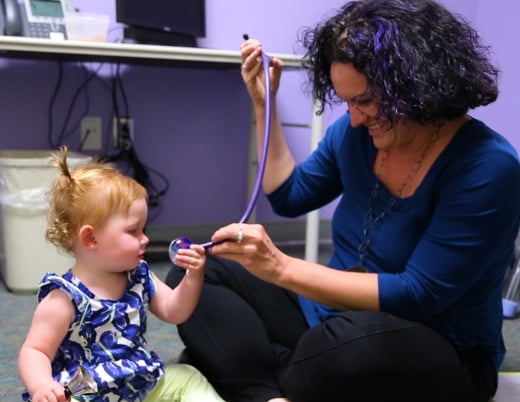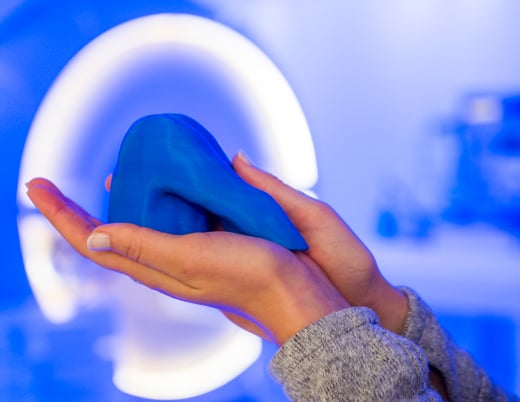Key takeaways
-
Prior to this study, there was no research on the use of amniotic fluid microRNA profiles to identify TTTS cases with severe recipient cardiomyopathy.
-
Study authors characterized amniotic fluid microRNA in TTTS cases and uncovered additional biological insight into the fetal pathophysiology of recipient cardiomyopathy associated with TTTS.
-
They identified amniotic fluid microRNAs that may serve as biomarkers of disease severity.
-
The goal is to determine if these markers are seen in the maternal blood with the long-term goal of determining if these markers can be used to predict which patients will develop severe TTTS.
Stats:
- 15% of all twin perinatal deaths are caused by TTTS
- 28.8 weeks is the average gestational age at delivery for TTTS patients with severe cardiomyopathy
- 80.8% sensitivity and specificity for all three identified miRNAs
Research background: challenges diagnosing, identifying biomarkers for TTTS
Twin-twin transfusion syndrome (TTTS) is caused by an imbalance in the blood volume and the vasoactive mediators between two fetuses vascularly connected to one placenta. When this happens, one twin’s blood volume depletes, and the other’s significantly increases. This drastic fluctuation leads to TTTS, which causes 15% of all twin perinatal deaths and up to half of mono-chorionic diamniotic (MCDA) twin deaths.
One of the fetuses can also develop cardiomyopathy, potentially caused by activating the renin-angiotensin-aldosterone system (RAAS) in the donor twin, causing hypovolemia, which is transferred to the other twin through the placental anastomoses. Additionally, the cardiomyopathy in one twin could lead to right ventricle outflow tract obstruction, which increases the chances of morbidity and mortality.
TTTS is screened for during fetal ultrasounds, but the disease does not often present until the second trimester of pregnancy. Disease severity can be determined using the Quintero staging system, or through proposed Cincinnati modifications to the Quintero staging system. Disease progression does not correlate well with the initial stage of disease and TTTS beyond stage three is associated with high risk of severe complications or death in both twins.
Specific microRNAs (miRNAs) have recently been looked at as a potential biomarker for cancer and cardiovascular conditions in adults and children. Biomarkers could offer clues aiding in earlier detection and more precise timing for laser fetal intervention, which could improve outcomes, but none have been deemed clinically useful to detect TTTS.
Researchers from the Colorado Fetal Care Center at Children’s Hospital Colorado and the hospital’s Heart Institute sought to determine if amniotic fluid miRNAs could be used to detect recipient cardiomyopathy in TTTS cases.
Research methods: criteria and methodology for pregnancies with fetal echocardiography
Patients were included in the study if they received amnioreduction or selective fetoscopic laser photocoagulation from the Colorado Fetal Care Center and had evidence of an MCDA twin gestation with TTTS at any point during their pregnancy. Sonography was performed by experienced fetal cardiac sonographers and interpreted by a pediatric cardiologist.
Researchers collected amniotic fluid from patients while they were at the Center for an amnioreduction or SELP procedure, which was cryopreserved. To define severe cardiomyopathy, the researchers used an RV MPI Z-score of less than four (less than 0.64 if using the Cincinnati modification of the Quintero staging system).
Research results: significance of using amniotic fluid microRNA as a biomarker
In total, 14 TTTS pregnancies with severe cardiomyopathy were compared to 12 TTTS controls with normal cardiac function in the study analysis.
The average age for mothers in both groups was 27.8 (control group) and 28.3 (pregnancy with severe cardiomyopathy). More patients had undergone SFLP (14; 11, respectively) than amnioreduction (0;1).
Pregnancy outcomes
| Outcome | Severe Cardiomyopathy Group | Control Group |
|---|---|---|
| Gestational age at delivery (in weeks) | 28.8 | 28.1 |
| Latency from procedure to delivery (in weeks) | 8.5 | 8.6 |
| Neonatal survival of both twins | 8 | 8 |
| Neonatal survival of one twin | 3 | 3 |
| Neonatal survival of neither twin | 3 | 1 |
Researchers found 110 miRNAs in the patient’s amniotic fluid samples; 20 of these were significant. Three provided the strongest indication (80.8% specificity) of severe cardiomyopathy compared to the control group:
- miR-200c-3p
- miR-17-5
- miR-539-5p
Research discussion: identifying specific miRNA as biomarkers to detect severe cardiomyopathy in TTTS pregnancies
Overall, all three of the top identified miRNAs have the potential to be diagnostic biomarkers for detecting severe recipient cardiomyopathy in TTTS pregnancies. These findings corroborate previous research that emphasized the significance of using miRNA and mRNA types as biomarkers for conditions associated with twin pregnancies.
Key findings about the top three identified miRNAs
- miRNA-17: cardioprotective and involved in stress adaptation, collagen secretion, fibroblast proliferation and resistant to apoptosis
- miRNA-200c: cardioprotective; if not regulated, can lead to hypoxia-induced apoptosis, cardiomyocyte hypertrophy, cardiomyocyte ion channel remodeling and oxidative stress response
- miRNA-539: regulates mitochondrial fission and apoptosis and can become unregulated in those diagnosed with Duchenne muscular dystrophy
Research conclusion/clinical implication: significance and relevance of identified miRNAs for TTTS severity
While the identified miRNAs have the potential to revolutionize the way pediatric cardiologists and fetal sonographers diagnose severe cardiomyopathy in TTTS pregnancies, not all hospitals or children’s centers will have access to the technology needed to conduct the procedures.
Another study limitation was the requirement for an invasive procedure to obtain amniotic fluid. In this study, all pregnancies were already undergoing therapeutic entry of the amniotic sac.
More studies should be performed on relevant biomarkers such as maternal blood and unique fetal cardiac cases to make the research more inclusive.
Featured Researchers

Henry Galan, MD
Maternal Fetal Medicine Specialist
Colorado Fetal Care Center
Children's Hospital Colorado
Professor
OB-GYN-Maternal Fetal Medicine
University of Colorado School of Medicine
Bettina Cuneo, MD
Fetal cardiologist

Shelley Miyamoto, MD
Chair of Pediatric Cardiology, Co-Director of the Heart Institute
Children's Hospital Colorado
Section Head of Cardiology, Department of Pediatrics
Pediatric Cardiology
University of Colorado School of Medicine





 720-777-0123
720-777-0123










